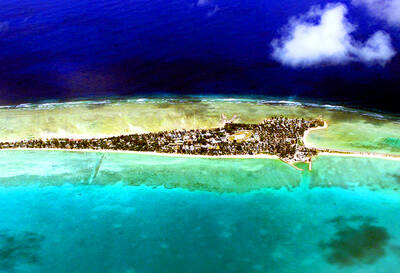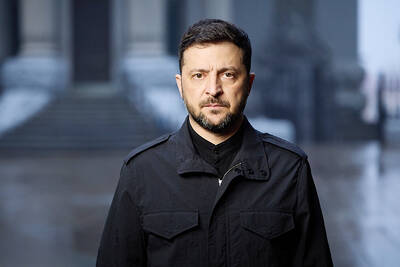Nations rallied behind plans for a network to detect tsunamis in the Indian Ocean and warn coastal residents of the danger, and pledged millions of US dollars yesterday for the UN to lead the effort to build one.
A tsunami alert system for the Indian Ocean has become a priority since the Dec. 26 tsunami -- triggered by a powerful earthquake off the coast of Indonesia -- killed an estimated 220,000 people in Asia and Africa.
The UN Educational, Scientific and Cultural Organization has proposed a network of deep-sea buoys in the Indian Ocean and regional communications centers that would cost US$30 million and go into operation by the middle of next year.
On the third day of a five-day UN conference in Kobe, delegates gave the go-ahead to start examining various proposals.
Salvano Briceno, who heads the UN action plan for preventing disasters, said several donors had agreed to help pay for startup costs. Though the final tally was expected later yesterday, so far Japan had offered US$4 million, Sweden US$1.5 million and the European Commission US$2.6 million. Germany and Britain also promised aid.
"In a matter of a year to 18 months, there should be a basic regional capacity on tsunami early warning system," Briceno, director of the UN International Strategy for Disaster Reduction, told a news conference. "There are enough resources to start working."
How the system will work -- and whether it can mesh nations' different networks and technologies -- remains unclear. US Ambassador to Japan Howard Baker Jr. said Thursday that Washington supports expanding a warning system for the Pacific Ocean that was established in 1965. That system -- which uses ocean sensors and satellite communication links to monitor the potentially killer waves in the quake-prone Pacific -- now sends tsunami alerts to 26 nations.
Germany has offered to provide a high-tech system that relies on ocean-floor pressure gauges and buoys connected to a satellite-based Global Positioning System.
Experts say the technology could be easily transferred to southern Asia. However, the lack of communication with coastal residents remains an obstacle in poor countries, they say.
"Early warning systems will only succeed if the people most at risk who are central to the design of a system are able to receive and act upon the warnings," said Ian Wilderspin, an official representing the International Federation of Red Cross and Red Crescent Societies.
Eventually, US officials say the Pacific system could also extend to the Mediterranean, Caribbean and other parts of the globe.
But Briceno stressed that the UN, not the US, would lead the effort. He said that while the US and Japan would be asked to lend their expertise on tsunami prediction, UN officials want to tailor the Indian Ocean system to the needs of poor Asian and African countries.
"By putting [the network] under the guidance of the UN, it ensures all countries participate on equal terms," Briceno said.
UN agencies will ask Germany, Australia and China for technical assistance, he said.

DISASTER: The Bangladesh Meteorological Department recorded a magnitude 5.7 and tremors reached as far as Kolkata, India, more than 300km away from the epicenter A powerful earthquake struck Bangladesh yesterday outside the crowded capital, Dhaka, killing at least five people and injuring about a hundred, the government said. The magnitude 5.5 quake struck at 10:38am near Narsingdi, Bangladesh, about 33km from Dhaka, the US Geological Survey (USGS) said. The earthquake sparked fear and chaos with many in the Muslim-majority nation of 170 million people at home on their day off. AFP reporters in Dhaka said they saw people weeping in the streets while others appeared shocked. Bangladesh Interim Leader Muhammad Yunus expressed his “deep shock and sorrow over the news of casualties in various districts.” At least five people,

It is one of the world’s most famous unsolved codes whose answer could sell for a fortune — but two US friends say they have already found the secret hidden by Kryptos. The S-shaped copper sculpture has baffled cryptography enthusiasts since its 1990 installation on the grounds of the CIA headquarters in Virginia, with three of its four messages deciphered so far. Yet K4, the final passage, has kept codebreakers scratching their heads. Sculptor Jim Sanborn, 80, has been so overwhelmed by guesses that he started charging US$50 for each response. Sanborn in August announced he would auction the 97-character solution to K4

SHOW OF FORCE: The US has held nine multilateral drills near Guam in the past four months, which Australia said was important to deter coercion in the region Five Chinese research vessels, including ships used for space and missile tracking and underwater mapping, were active in the northwest Pacific last month, as the US stepped up military exercises, data compiled by a Guam-based group shows. Rapid militarization in the northern Pacific gets insufficient attention, the Pacific Center for Island Security said, adding that it makes island populations a potential target in any great-power conflict. “If you look at the number of US and bilateral and multilateral exercises, there is a lot of activity,” Leland Bettis, the director of the group that seeks to flag regional security risks, said in an

‘DIGNITY’: The Ukrainian president said that ‘we did not not betray Ukraine then, we will not do so now,’ amid US pressure to give significant concessions to Russia Ukrainian President Volodymyr Zelenskiy on Friday pushed back against a US plan to end the war in Ukraine, while Russian President Vladimir Putin welcomed the proposal that includes many of his hardline demands. With US President Donald Trump giving Ukraine less than a week to sign, Zelenskiy pledged to work to ensure any deal would not “betray” Ukraine’s interests, while acknowledging he risked losing Washington as an ally. Putin said the blueprint could “lay the foundation” for a final peace settlement, but threatened more land seizures if Ukraine walked away from negotiations. Ukraine faces one of the most challenging moments in its history,